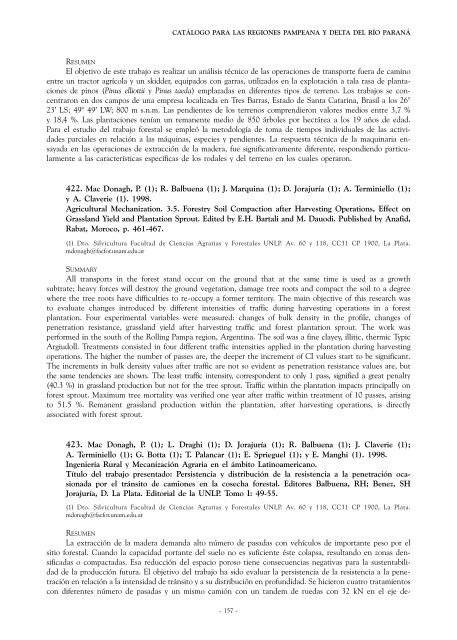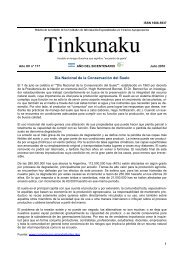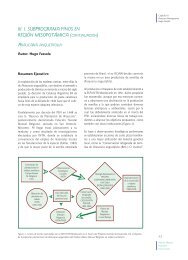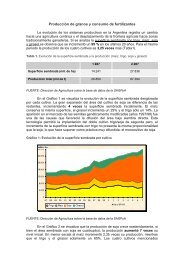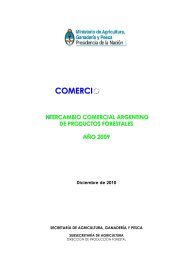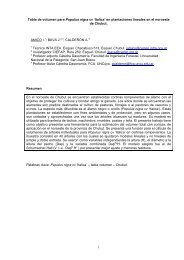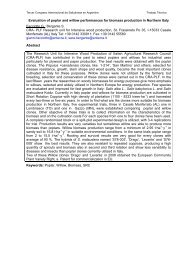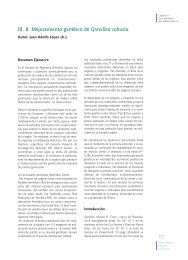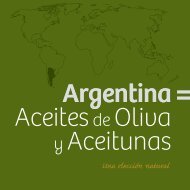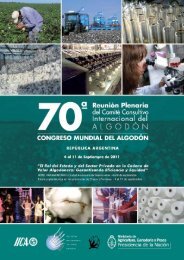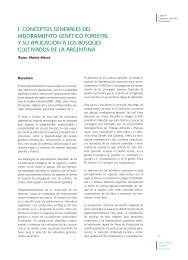catálogo para las regiones pampeana y delta del río parana
catálogo para las regiones pampeana y delta del río parana
catálogo para las regiones pampeana y delta del río parana
You also want an ePaper? Increase the reach of your titles
YUMPU automatically turns print PDFs into web optimized ePapers that Google loves.
CATÁLOGO PARA LAS REGIONES PAMPEANA Y DELTA DEL RÍO PARANÁRESUMENEl objetivo de este trabajo es realizar un análisis técnico de <strong>las</strong> operaciones de transporte fuera de caminoentre un tractor agrícola y un skidder, equipados con garras, utilizados en la explotación a tala rasa de plantacionesde pinos (Pinus elliottii y Pinus taeda) emplazadas en diferentes tipos de terreno. Los trabajos se concentraronen dos campos de una empresa localizada en Tres Barras, Estado de Santa Catarina, Brasil a los 26°23’ LS; 49° 49’ LW; 800 m s.n.m. Las pendientes de los terrenos comprendieron valores medios entre 3,7 %y 18,4 %. Las plantaciones tenían un remanente medio de 850 árboles por hectárea a los 19 años de edad.Para el estudio <strong>del</strong> trabajo forestal se empleó la metodología de toma de tiempos individuales de <strong>las</strong> actividadesparciales en relación a <strong>las</strong> máquinas, especies y pendientes. La respuesta técnica de la maquinaria ensayadaen <strong>las</strong> operaciones de extracción de la madera, fue significativamente diferente, respondiendo particularmentea <strong>las</strong> características específicas de los rodales y <strong>del</strong> terreno en los cuales operaron.422. Mac Donagh, P. (1); R. Balbuena (1); J. Marquina (1); D. Jorajuría (1); A. Terminiello (1);y A. Claverie (1). 1998.Agricultural Mechanization. 3.5. Forestry Soil Compaction after Harvesting Operations, Effect onGrassland Yield and Plantation Sprout. Edited by E.H. Bartali and M. Dauodi. Published by Anafid,Rabat, Moroco, p. 461-467.(1) Dto. Silvicultura Facultad de Ciencias Agrarias y Forestales UNLP. Av. 60 y 118, CC31 CP 1900, La Plata.mdonagh@facfor.unam.edu.arSUMMARYAll transports in the forest stand occur on the ground that at the same time is used as a growthsubtrate; heavy forces will destroy the ground vegetation, damage tree roots and compact the soil to a degreewhere the tree roots have difficulties to re-occupy a former territory. The main objective of this research wasto evaluate changes introduced by different intensities of traffic during harvesting operations in a forestplantation. Four experimental variables were measured: changes of bulk density in the profile, changes ofpenetration resistance, grassland yield after harvesting traffic and forest plantation sprout. The work wasperformed in the south of the Rolling Pampa region, Argentina. The soil was a fine clayey, illitic, thermic TypicArgiudoll. Treatments consisted in four different traffic intensities applied in the plantation during harvestingoperations. The higher the number of passes are, the deeper the increment of CI values start to be significant.The increments in bulk density values after traffic are not so evident as penetration resistance values are, butthe same tendencies are shown. The least traffic intensity, correspondent to only 1 pass, signified a great penalty(40.3 %) in grassland production but not for the tree sprout. Traffic within the plantation impacts principally onforest sprout. Maximum tree mortality was verified one year after traffic within treatment of 10 passes, arisingto 51.5 %. Remanent grassland production within the plantation, after harvesting operations, is directlyassociated with forest sprout.423. Mac Donagh, P. (1); L. Draghi (1); D. Jorajuría (1); R. Balbuena (1); J. Claverie (1);A. Terminiello (1); G. Botta (1); T. Palancar (1); E. Sprieguel (1); y E. Manghi (1). 1998.Ingeniería Rural y Mecanización Agraria en el ámbito Latinoamericano.Título <strong>del</strong> trabajo presentado: Persistencia y distribución de la resistencia a la penetración ocasionadapor el tránsito de camiones en la cosecha forestal. Editores Balbuena, RH; Benez, SHJorajuría, D. La Plata. Editorial de la UNLP. Tomo I: 49-55.(1) Dto. Silvicultura Facultad de Ciencias Agrarias y Forestales UNLP. Av. 60 y 118, CC31 CP 1900, La Plata.mdonagh@facfor.unam.edu.arRESUMENLa extracción de la madera demanda alto número de pasadas con vehículos de importante peso por elsitio forestal. Cuando la capacidad portante <strong>del</strong> suelo no es suficiente éste colapsa, resultando en zonas densificadaso compactadas. Esa reducción <strong>del</strong> espacio poroso tiene consecuencias negativas <strong>para</strong> la sustentabilidadde la producción futura. El objetivo <strong>del</strong> trabajo ha sido evaluar la persistencia de la resistencia a la penetraciónen relación a la intensidad de tránsito y a su distribución en profundidad. Se hicieron cuatro tratamientoscon diferentes número de pasadas y un mismo camión con un tandem de ruedas con 32 kN en el eje de-- 157 -


